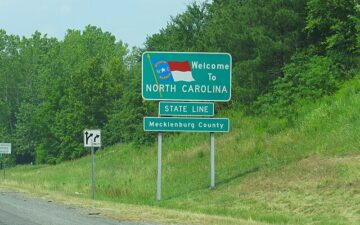North Carolina: Census 2020 Real-Time Response Rates – Week ending May 26 (.pdf)
View All County-Level Response Rates –
Week ending May 26
Key takeaways for week ending May 26
- North Carolina maintains ranking of 34 out of 50 states and DC. With a response rate of 56.4% of households, this remains North Carolina’s highest ranking since reporting began in March. The highest ranking state in the nation is Minnesota, with a response rate of 70.0%.
- North Carolina response growing closer to national average, but large gap remains. As of May 25th, 56.4% of NC households had self-responded to the 2020 Census, below the national average of 60.1%. This gap of 3.7 percentage points is slightly smaller than last week (3.8 percentage points) and is entirely driven by lower online response rates: 44.4% in NC versus 48.4% nationwide.
- North Carolina outranked by five southeastern states. Since reporting began, North Carolina’s response rate has surpassed three states in the southeast: Arkansas, Mississippi, and Georgia. For the second week, it is now outranked by just five states in the region: Virginia (65.2%), Kentucky (63.8%), Tennessee (60.1%), Alabama (58.2%), and Florida (57.6%).
- Four counties now meet or exceed North Carolina’s 2010 state self-response rate (64.8%). These are: Union County (68.1%), Orange County (66.4%), Wake County (65.6%), and now Davie County (64.8%).
- Response rate gap did not change between the state and tracts with the smallest share of young children. Previously, the response rate gap had widened each week between the state and tracts with less than 4.1% of young children. It remains 2.3 percentage points: an average of 54.1% of households in tracts with the fewest young children vs. 56.4% of households statewide.
- Tracts with the highest share of foreign-born residents continue to outperform the state and tracts with smaller immigrant populations. In tracts where 5.7% to 9.8% of the population is foreign-born, an average of 58.2% of households responded to the Census – 1.8 percentage points above the state. Similarly, in tracts where >9.8% of the population is foreign-born, households’ response rate was 1.6 percentage points above the state. This trend has maintained throughout the entire reporting period.
- Response rate gap also remained unchanged between the state and tracts where >50% of residents are non-white. For the second week, the gap was 6.8 percentage points between the state and the average for households in tracts with the largest share of minority residents – 49.6% for these households vs. 56.4% for all households in NC.
- Since the start of reporting, internet access remains the greatest indicator of low response. The gap between households with low internet access and the state has remained the largest since reporting began for all target groups. Currently, an average of 48.2% of households with low internet access have responded to the Census – 8.2 percentage points below the state.
Last updated: 5.28.20


